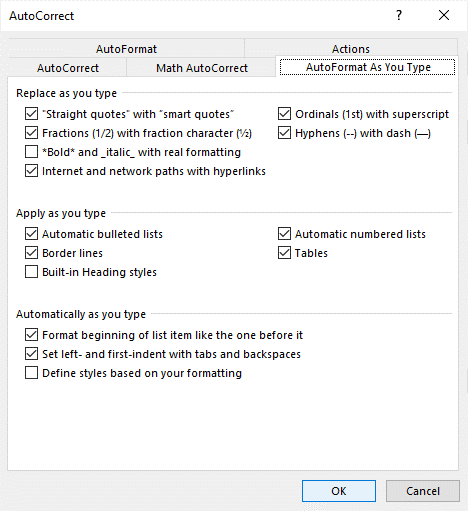

The attributes of this element contain information about when this revision took place (in other words, when these properties became a "former" set of paragraph properties).Ĭonsider a paragraph in a WordprocessingML document which is centered, and this change in the paragraph properties is tracked as a revision. The child element of this element contains the complete set of paragraph properties which were applied to this paragraph before this revision. This element stores this revision as follows: This element specifies the details about a single revision to a set of paragraph properties in a WordprocessingML document. *pPrChange (Revision Information for Paragraph Properties) The following information from the ISO/IEC 29500 specification introduces the ParagraphPropertiesChange element ( pPrChange).
#Accept all formatting changes in word code
In the following sections, you read about three elements that are used in the code to change the paragraph contents, mainly, (Revision Information for Paragraph Properties), (Deleted Paragraph), and (Inserted Table Row) elements. When you accept a revision mark, you change the properties of a paragraph either by deleting an existing text or inserting a new text. The container for the block level structures such as paragraphs, tables, annotations and others specified in the ISO/IEC 29500 specification. The root element for the main document part.

The following table lists the class names of the classes that correspond to the document, body, p, r, and t elements. You will find these classes in the namespace. Using the Open XML SDK 2.5, you can create document structure and content using strongly-typed classes that correspond to WordprocessingML elements. The following code example shows the WordprocessingML markup for a document that contains the text "Example text." The r stands for run, which is a region of text with a common set of properties, such as formatting. A paragraph contains one or more r elements. The basic document structure of a WordProcessingML document consists of the document and body elements, followed by one or more block level elements such as p, which represents a paragraph. Because the WordprocessingDocument class in the Open XML SDK automatically saves and closes the object as part of its System.IDisposable implementation, and because Dispose is automatically called when you exit the block, you do not have to explicitly call Save and Close as long as you use using. The block that follows the using statement establishes a scope for the object that is created or named in the using statement, in this case wdDoc. It ensures that the Dispose method (internal method used by the Open XML SDK to clean up resources) is automatically called when the closing brace is reached. The using statement provides a recommended alternative to the typical. Using wdDoc As WordprocessingDocument = WordprocessingDocument.Open(fileName, True) using (WordprocessingDocument wdDoc = WordprocessingDocument.Open(fileName, true)) To do so, you open the word processing file with the specified fileName by using the Open(String, Boolean) method, with the Boolean parameter set to true in order to enable editing the document. To open an existing document, you can instantiate the WordprocessingDocument class as shown in the following using statement. The following assembly directives are required to compile the code in this topic.
#Accept all formatting changes in word how to
This will open a dialog box where you can access all of the basic settings, plus some more advanced ones that you won't find on the Ribbon.This topic shows how to use the Open XML SDK 2.5 for Office to accept all revisions in a word processing document programmatically. To find out if you can customize the default settings for a certain element, look for an arrow in the bottom-right corner of the group.

You can't change the default settings for everything in Word, but there are certain tools and features that give you this option. Luckily, you can customize many of the default settings in Word. Maybe you even work for a company that has very specific document standards-regarding the color scheme or layout-and you're tired of changing these settings every time. Maybe you like all of your documents to have narrower margins so you can fit more information on the page.

Maybe you prefer a different font style instead of the default Calibri. There may be certain settings in Word that get on your nerves, like default settings that you find yourself changing over and over-the paragraph spacing, the font size-each time you start a new document. en/word-tips/how-to-create-a-bibliography-or-works-cited-page-in-word/content/ Changing your default settings in Word Lesson 17: Changing Your Default Settings in Word


 0 kommentar(er)
0 kommentar(er)
